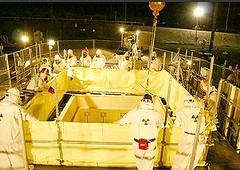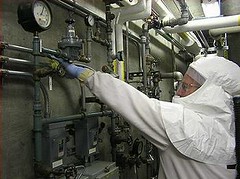 美國華盛頓州中部的韓福德核廢料場(Handford Nuclear Site)首次從雙層護殼的廢料儲存槽偵測到高輻射滲透。
美國華盛頓州中部的韓福德核廢料場(Handford Nuclear Site)首次從雙層護殼的廢料儲存槽偵測到高輻射滲透。
公益團體「韓福德挑戰」(Hanford Challenge)8月17日公開了一份美國能源部調查人員傳給華盛頓州生態署(Washinnton State Department of Ecology)的一份備忘錄,備忘錄中對核廢料滲漏狀況有詳盡的記錄。
完成日期為8月14日的備忘錄,確認在8月初偵測到高輻射化學廢棄物滲漏,滲漏處在編號AY-102儲存槽雙層護殼間中空帶(annulus)的地板上。
記錄中提到在地板上發現兩處乾的輻射廢棄物,有一處形成了一個長2呎寬3呎高8吋的小丘。
「這個發現改變一切,現在有具體的證據證明韓福德雙層儲存槽有滲漏,」韓福德挑戰執行主任卡本特(Tom Carpenter)表示,「這些雙層槽本來預計可以再使用40年,這項新發現讓這種想法不得不改弦更張。」
位在美國哥倫比亞河(Columbia River)邊的韓福德核廢料處,占地584平方英哩,儲存了2/3美國在第二次世界大戰及冷戰期間製造鈽所產生的廢料,這些廢料含高量輻射。在1988年以前,韓福德是製造鈽的廠址。
目前,韓福德是全美輻射污染最嚴重的地點,因而也是全國最大也最受矚目的環境清理標的。
AY-102儲存槽是韓福德地下核廢料儲存場177個槽之一,這些大槽儲存了5600萬加崙高輻射的核廢料。
 韓福德現址旁正在興建一座全球最大的核廢料處理及固化廠(Waste Treatment and Immobilization Plant),建好前現存的核廢料仍得置放儲存場,無法處理。
韓福德現址旁正在興建一座全球最大的核廢料處理及固化廠(Waste Treatment and Immobilization Plant),建好前現存的核廢料仍得置放儲存場,無法處理。
根據這座處理廠的承包商Bechtel National, Inc表示,新廠於2001開工,至今已完成65%。峻工後,可以在廠裡將核廢料加熱,混入製造玻璃的物質,再倒入不銹鋼槽內封存。變成玻璃的核廢料十分穩定,不會滲漏到附近的環境。
韓福德儲存場中已經有67個儲存槽陸續滲漏了100萬加崙以上的核廢料,污染了鄰近的土壤,不過,過去發生滲漏的都是舊式的單層儲存槽。
這些單層槽內的廢料陸續被移入雙層的儲存槽以策安全,雙層槽均是鋼製,中間並留有中空帶,以增加安全餘地。
此次發現有滲漏的AY-102便是雙層槽,之前都以為雙層槽穩定強固,不會滲漏。
能源部負責韓福德核廢料儲存槽事務的副處長傅雷契(Tom Fletcher)告知新聞媒體Tri-City Herald,「如果我們確認有新滲漏或之前溢出的廢料,表示清空這些儲存槽已急不容緩,這些槽已經老舊不堪了。」
傅雷契表示,能源部尚未確認滲漏的物質為何,從何處露出。
調查人員正在偵查廢料到底是從AY-102的內殼滲漏出來,還是源自其他地方,比方支援AY區儲存槽的幫浦及管線。
這次的滲漏是透過監視錄影得知,出現問題的區域過去不曾用錄影監視。
備忘錄中記錄,近期內調查人員會檢查「人員進得去的所有槽間中空帶」以及「第三層(確保第二個內層防護完整)滲漏偵測穴取得的樣本」。
 長期來說,調查人員會進一步確認還有沒有其他的雙層槽滲漏,並「設法移除已滲漏在槽間中空帶的滲漏物」。
長期來說,調查人員會進一步確認還有沒有其他的雙層槽滲漏,並「設法移除已滲漏在槽間中空帶的滲漏物」。
能源部的調查人員會加強滲漏處的監視,一周兩次以錄影方式監視,並在各個工作時段都進行監視;也會從兩處滲漏處取樣檢驗。
華盛頓州生態署核廢料部門負責廢料清理的主任華崚(Cheryl Whalen)告訴報社記者,如果雙層槽都會滲漏,「那麼,情況就會變得有點麻煩,因為這樣會妨礙到將廢料從易漏的單槽移到雙槽的工程。」
2002年以來,韓福德已有200萬加崙的核廢料從單層的儲存槽被移到雙層儲存槽,等待進一步的固化處理。
卡本特說,「這項新的證據將促使能源部加速興建更多雙層槽。我們一直都知道雙層槽遲早也會漏,只是不知在何時,現在已經有了第一個,接下來的40年還會有多少個陸續滲漏呢?」
「唯一的好消息是滲漏的不是液體,也明顯還沒對環境造成影響。」
將備忘錄內容公開的卡本特,也批評能源部資訊不肯透明化。他說,「官員得悉滲漏已經一個多星期,至今卻仍未以任何形式公布,保密與隱藏問題的時代已經過去,但官方顯然還是惡習不改。」
「韓福特挑戰」也指出,新的廢料處理廠的啟用仍充滿變數,新廠由於被查出仍有安全疑慮,仍在等待詳細審查。卡本特說,「也因此政府必須立刻興建一系列新槽,暫時儲放韓福德的致命廢料。」
【相關文章】韓福德核子廢料處理場安全堪慮
For the first time, a leak of highly radioactive waste has been detected from a double-shelled tank at the Hanford Nuclear Site in central Washington state.
The public interest group Hanford Challenge Friday released disclosed a memo from U.S. Department of Energy inspectors to the Washington State Department of Ecology detailing the leak.
Dated August 14, the memo acknowledges a highly-radioactive chemical waste leak that was detected in early August from Tank AY-102 on the floor of the “annulus,” the space between the two walls of the double-shell tank.
The dry radioactive waste was found in two locations, according to the memo, one of them in a “mound approximately 2 ft. x 3 ft. x 8 inches.”
“This changes everything. It is alarming that there is now solid evidence that a Hanford double-shell has leaked,” said Hanford Challenge Executive Director Tom Carpenter. “These tanks were supposed to last another 40 years, but that thinking has been superseded by this new reality.”
The 586-square-mile Hanford Site on the Columbia River holds two-thirds of the nation’s high-level radioactive waste left over from plutonium production during World War II and the Cold War. Plutonium production ended at Hanford in 1988.
Today, Hanford is the most contaminated nuclear site in the United States and is the focus of the nation’s largest environmental cleanup.
The AY-102 tank is one of 177 underground nuclear waste tanks at Hanford, containing an estimated 56 million gallons of high-level nuclear waste.
The waste is being held until it can be treated at the world’s largest Waste Treatment and Immobilization Plant now under construction at the site.
vitrification plant
At the treatment plant the waste will be heated, mixed with glass-forming materials and poured into stainless steel containers. In this vitrified form, the waste is stable and impervious to the environment. Construction of the Vit Plant began in 2001 and is more than 65 percent complete, according to the contractor, Bechtel National, Inc.
Sixty-seven Hanford tanks have leaked over one million gallons of radioactive waste into the soil, but until now, all of them were the older-style, single-shell tanks.
The waste in the single-shell tanks is being moved into the tanks with double shells as a safety measure. Double-shelled tanks have two steel walls, with a “tank within a tank” design that adds to the safety margin.
The AY-102 tank is a double-shell waste tank, and had been considered to be stable and non-leaking.
“If we determine there was a leak or a previous spill, it reinforces the urgency of emptying the tanks and completing the mission,” Tom Fletcher, Department of Energy assistant manager of the tank farms, told the “Tri-City Herald” newspaper. “The tanks are not getting any younger.”
The Department of Energy has not confirmed exactly what the material is or where it came from, Fletcher said.
Investigators are attempting to determine whether waste leaked out of the inner shell of Tank AY-102 or the waste originated from another source, such as a pit with pumps or piping serving the AY Tank Farm.
The leak was discovered during video monitoring of an area that had not previously been subject to monitoring.
Now, the memo says, in the near term inspectors will examine “all accessible areas of tank annulus” and “sample and pump tertiary leak detection pit (confirms secondary liner integrity).
Hanford worker
In the long term, inspectors will determine if other double-shell tanks are leaking and “explore means for removing material from annulus.”
Department of Energy, DOE, inspectors will increase monitoring in the area of the leak, with visual monitoring twice a week and level monitoring on each work shift; and they will sample the leaked waste material in both locations.
The Washington State Department of Ecology’s Nuclear Waste Program cleanup section manager Cheryl Whalen told the newspaper that if the double-shell tanks are leaking, “it will be a difficult situation” because it will hamper retrieval of the waste from the leak-prone single-shell tanks.
Since 2002, nearly two million gallons of waste have been retrieved from single-shell tanks at Hanford and transferred to the newer, double-shell tanks to await treatment.
Carpenter said, “This new evidence gives urgency to the suggestion that the DOE build more tanks. We always knew the double-shell tanks would leak, we just did not know when. We have the first, how many will be leakers in another 40 years?”
“The only good news here is that the waste from this tank leak was not in liquid form, and is apparently not yet affecting the environment,” he said.
Carpenter, who released the official memo detailing the leak, is critical of the Department of Energy for its lack of transparency.
“Officials have not made any kind of announcement about the leak, despite the fact that they have known for over a week,” he said. “The era of secrecy and hiding problems is supposed to be over, but old habits apparently die hard.”
Hanford Challenge also points to uncertainties around the opening of the Waste Treatment Plant, which is under scrutiny because of safety issues raised by whistleblowers. Carpenter says that is another reason why the government “should immediately build a new set of tanks to temporarily store Hanford’s deadly waste.”
※ 全文及圖片詳見:ENS





